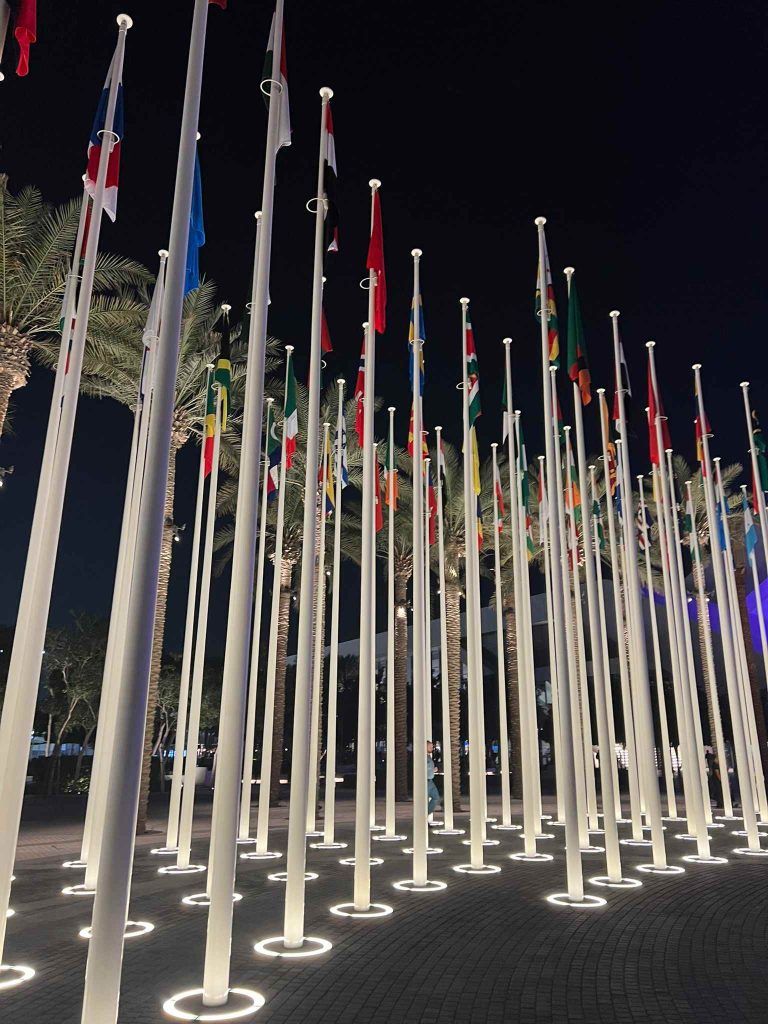
Image credit Hannah Case: flag poles at COP28 night view
Written by PhD student Philippa Oppenheimer from SCENARIO DTP
The impact of humans on the world is becoming increasingly clear. Excessive carbon emissions are resulting in climate change defined by unprecedented wildfires, floods, storms, and droughts. However, the consequences of changes in the amount or locations of the world’s wildlife are not as clear to see and are often overlooked. As COP28 unfolds over the next two weeks, it’s imperative that we consider the vital role of nature in both reducing the impacts (mitigating) and adapting to the challenges of climate change.
The United Nations’ annual climate change conference, while significant, is not the only global environment-focused meeting. In December 2022 the world came together at the lesser known COP15 in Montreal for the biannual UN Convention on Biological Diversity (CBD) conference. Here, the landmark Global Biodiversity Framework was agreed by the 196 parties aimed to set nature on the path to recovery by 2030. The framework requires nations to deliver on 23 targets including the need to reduce the impacts of climate change on nature. COP28 is the opportunity to start working on putting these targets into action.
While climate change accelerates the loss of nature, the loss of nature also accelerates the progress of climate change. There is increasing recognition that nature’s contribution to people, things like providing food, medicine and clean air and water, are being put under increasing risk. Human actions such as over-hunting, deforestation and pollution have resulted in a 69% decline in monitored animal populations since 1970. Climate change only enhances the damaging impacts of these human actions.
A central conversation at COP this year will revolve around the negotiation of a Global Goal on Adaptation (GGA). The GGA is a collective commitment from parties to “enhancing adaptive capacity, strengthening resilience, and reducing vulnerability to climate change.” This commitment presents a unique opportunity to intertwine global adaptation efforts with the resurgence of nature through nature-based solutions.
For example, restoring our coastal wetlands to healthy levels can protect against coastal erosion and provide a buffer against sea level rise. This would also contribute to our targets as part of the CBD Global Biodiversity Framework.
So, can COP28 be a turning point for nature? Several questions need resolution, such as how progress towards the goal will be measured. This poses a challenge for nature-based approaches to adaptation due to the difficulty in measuring or predicting their effectiveness. This is mainly due to the context specific factors which result in different results where the approaches are used. A suite of context-specific indicators will be needed to effectively measure adaptation progress using nature-based solutions.
A golden thread through all conversations will be how any adaptation measures can be financed. Meeting the final adaptation goal will require parties to agree on and deliver on the Adaptation fund. With a current US$ 194 – 366 billion a year shortfall in funding, parties will have to show major ambition on the change of global finance flows. However, with an estimated reduction of the required funding in 2030 by US$104 billion, nature-based solutions emerge as the only approaches offering potential reductions in funding amounts needed.
Whilst we must continue to reduce our carbon emissions, we must also adapt to our new climate. Nature-based solutions stand as a key tool to enhance resilience and mitigate climatic impacts. This conference is an opportunity to articulate a global plan for a changing world. Recognising the link between nature and climate is critical for a sustainable future, ensuring fulfilment of our environmental commitments after COP28 and beyond.

